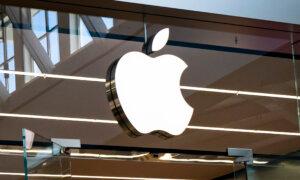The iPhone maker gave its cash dividend a 4 percent boost.
Shares of Apple fell about 2 percent in extended trading on May 1 despite beating Wall Street expectations for the company’s second fiscal-quarter earnings.
The iPhone maker reported $95.4 billion in revenues, higher than the consensus forecast of $94.66 billion. Overall revenues were driven by better-than-expected performances for the iPhone ($46.84 billion), Mac (7.95 billion), and iPad ($6.4 billion).
However, Apple fell short of analysts’ estimates in two categories: services ($26.65 billion) and wearables, home, and accessories ($7.52 billion).
Apple CEO Tim Cook was still pleased with double-digit growth in services.
“We were happy to welcome iPhone 16e to our lineup, and to introduce powerful new Macs and iPads that take advantage of the extraordinary capabilities of Apple silicon,” he said in a statement.
Earnings per share—a Wall Street term that gauges how much profit the business made for each share of stock—were $1.65. This was slightly above the forecast of $1.63.
Apple also raised its cash dividend by 4 percent, to $0.26 per share.
Shares of Apple finished the May 1 trading session up 0.39 percent, to $213.32. The stock is down about 12.5 percent.
Apple is one of the latest so-called “Magnificent Seven” stocks—megacap companies with an outsized influence over the broader financial markets—to post quarterly earnings.
Electric vehicle maker Tesla Motors kicked off the earnings season with a 9 percent decline in revenues and a 40 percent drop in earnings per share.
Online retail giant Amazon also released its earnings shortly after the closing bell on May 1. The company topped Wall Street expectations in the first quarter, but traders were disappointed by the light second-quarter guidance.
Looking ahead, Wall Street analysts forecast a 9 percent upside in the stock price. At the same time, many market watchers, including Barclays, Raymond James, and Goldman Sachs, have lowered their price target.
Tariff Uncertainty Bites the Apple
Investors have been waiting for how the company will handle the new U.S. tariffs.
“There is very little clarity out there, and it is difficult to estimate (or guesstimate) the impact of tariffs,” said Jamie Meyers, a senior analyst at Laffer Tengler Investments, in a note to The Epoch Times.
Cook said as much.
In an earnings call with analysts and shareholders, Cook acknowledged that it will be “very difficult” to project tariff-related costs beyond June, “because I’m not sure what will happen with the tariffs.”
“We will manage the company the way we always have with thoughtful and deliberate decisions, with a focus on investing for the long term and with dedication to innovation and the possibilities it creates,” Cook said.
“As we look ahead, we remain confident.”
Market analysts say the full scope of how much tariffs will impact the tech juggernaut might not be observed until the next quarter.
Still, the latest earnings report and the stock’s performance could be a precursor to its tariff-driven movement.
President Donald Trump has imposed a 145 percent tariff on Chinese goods shipped into the United States, which experts say would have accelerated the cost of iPhones and other Apple products.
However, the White House provided temporary exemptions to a range of electronic devices and components imported into the United States last month.
“They’re exempt from the reciprocal tariffs, but they’re included in the semiconductor tariffs, which are coming in probably a month or two,” Commerce secretary Howard Lutnick said in an ABC interview on April 13.
During a recent interview with CNBC, Cook stated that the company is currently sourcing approximately half of its smartphones from the U.S. market from India.
“If you look at the other products, Mac and iPad and AirPods and the Watch, almost all of the country of origin is Vietnam,” Cook said.
While Apple recently announced a four-year, $500 billion U.S. investment, the company still plans to shift most of its iPhone manufacturing for the U.S. market to India. Approximately 80 percent of the iPhones sold in the United States are made in China.
This could be a years-long initiative, Meyers notes.
“We believe it would take many years to move even a portion of Apple’s supply chain to the United States,” Meyers added. “Sure, you can put them together here, but the parts are still coming from all over the world (and predominantly Southeast Asia and China). This would cause a material price increase for products.”
Apple will likely continue to diversify its manufacturing out of China, “but it will be a slog.”










Leave feedback about this